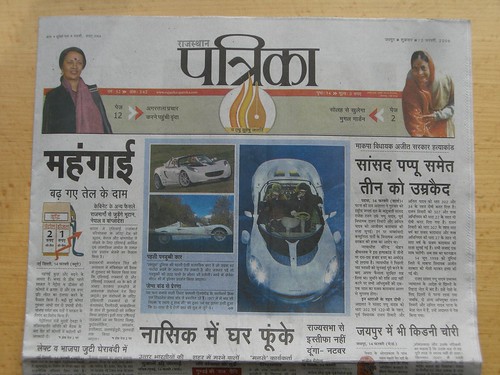21st Century Journalism XXXVIII: Training Rural Journalists in India
On January 14, India Knowledge@Wharton published an article reporting on what newspaper publishers in India are doing to attract rural readers. Despite a rural literacy rate of only 50% and road conditions that make delivery arduous, Indian newspapers are succeeding in maintaining circulation in rural areas by covering topics of local interest, marketing vigorously, and employing resourceful delivery people.
(Dan Reynolds)
The article opens with an account of rural distribution of a city paper, Rajasthan Patrika, and then goes on to describe a paper that is more strictly local:
Khabar Lahariya, or News Waves, [is] a weekly newspaper based in Chitrakoot, one of the poorest districts in central India. Written in Bundeli, the local language, the paper's all-female staff has forged a reputation for investigative journalism and support of grassroots causes since the paper was founded in 2002 by Nirantar, a New Delhi-based literacy education non-profit.Khabar Lahariya's training effort offers a promising model. You can get an idea of how Nirantar organizes its training workshops from an August 2007 report (pdf) that Nirantar has made available online.
With a readership of 35,000 in 400 villages and costing 4 U.S. cents, the paper has no glitzy promotion strategy like its urban counterparts. Khabar Lahariya's marketing strength is instead its bold reporting on issues concerning lower-caste communities, for which it won the 2009 King Sejong Literacy Prize from UNESCO, among other recent accolades. However, the main reason why Khabar Lahariya receives such kudos is that it is run by trained women from marginalized communities and it conducts (in conjunction with Nirantar) journalist training and writing programs for locals — a vital step, many believe, in increasing rural literacy.1

(Nirantar)
The workshop described in the report ran for seven days with eighteen participants. It was a mix of "group discussions, analysis of written material, field visits, film screening,2 debates, lectures and role plays."
The basic journalism concepts covered were:
- What constitutes news
- Sources of news
- Verifying sources
- Questioning gender norms
- Completing stories
- Effective interviewing
- Ways of writing up interviews (Q&A, feature story)
It is also notable that the workshop's interviewing role plays were especially well received:
This was definitely the highlight of this session: a combination of entertaining characterizations and the excitement of interacting with the trainers in a different role really worked to draw the group into the exercise. Six groups were formed, and each given a different character to interview — ranging from officials to interesting personalities (A sleazy District Magistrate, a boatwoman, a station master, a woman freedom fighter, a woman pradhan). They were given a situation, and asked to plan/prepare questions for the interview. Some of the issues that emerged were — how to deal with long, rambling, unfocussed interviewees; how to deal with officials behaving inappropriately (and thus distracting attention from the questions asked); and how to extract important information from sources who are busy/evasive. In general, the energy was high through this activity, and provided a spur to the field trips that followed.The report closes with notes on how the training was evaluated. To test retention the trainers used a competition, with questions in various forms — multiple choice, matching, true/false, and items dealing with more detailed issues covered inthe training. The trainers' assessment:
It was deeply heartening to see that most of the group had a grasp of the basic concepts of journalism, but also were able to articulate some of the more complex issues — of what news is important, and why, of how to write certain news. It was also an exhilarating way to end the fairly long and draining week we’d had.In addition, the trainers solicited oral and written feedback from the participants. In the oral feedback,
[m]any participants said they were nervous before they came ... – about the work that would be expected of them - but had enjoyed meeting so many people, and speaking to them, and learning so much. Many people listed the key concepts in the course (we were sure none of the 18 participants would ever forget what LEAD or KHABAR ["news"] or INTERVIEW meant!). [S]ome people shared the difficulty in understanding or remembering words that were used in the course ... but hoped that what they didn’t recall, they would in the work to follow. Uma shared what a different experience it was to be encouraged to go out and speak to so many different people.__________
1 You can see a sample 2007 edition of Khabar Lahariya here.
2The film used in the workshop was Mrityudand ("The Death Sentence"), a 1997 Hindi-language release.
3 In the Indian context, maintaining neutrality was difficult for some of the training participants because they felt that the (mythical) stories they learned in their religious instruction should take precedence over alternate stories based on standard journalistic fact-finding.
Labels: India, Journalism
<< Home